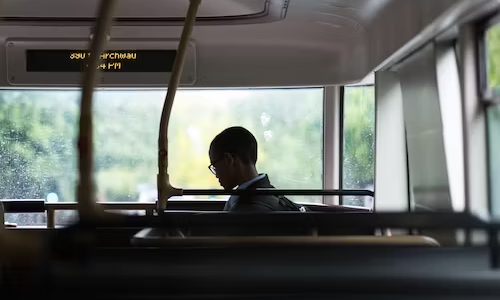Accessibility and Development: The Why
 Desiree Bradish
Desiree Bradish
Why do I specialize in Accessibility?
My experience with accessibility.
Growing up with a sister who is legally blind, I was lucky enough to experience a unique slice of the world. That is the world of living with vision loss. I was attending meetups for the visually impaired, and participating in after-hours Orientation and Mobility classes, where an instructor would reveal different techniques for navigating independently. I was actively involved in setting up and moderating Goal Ball Tournaments. More recently I’ve begun learning ASL & getting connections with the Deaf community as well.
I have seen the struggles that some have just in obtaining a job, being independent, and being allowed to choose what they want to do with their life. A lot of parents of children with disabilities like to guide their children, with the best of intent, towards a safe and dependent path.
I used the word allowed very intentionally. It is not that the Deaf are not able to hold positions beyond teaching at a deaf school, it isn't that blind people are unable to work in a million different positions, it is that roadblocks are placed in front of them by employers, organizations and family, to prevent them from reaching that position. More to our point as developers, there are also technological roadblocks. Non-accessible sites and technological tools aren't always built with everyone in mind.
The roadblocks to success.
The blocks begin at birth. Parents are afraid for their children, they unintentionally (Though sometimes intentionally) instill that fear into them as they grow.

I have a friend whose parents refused to allow her to cook or clean, who insisted that she would always need them to do things for her. They created dependence, and they took her confidence. However, when she became pregnant at 17 they threw her to the curb. After years of instilling a belief that she was less than able, not as strong or worthy as others. When she needed them the most, they abandoned her having not given her the tools she needed to live alone. Even worse, they abandoned her without the belief she could survive on her own. She did survive though. She went through a lot of struggles and learned all those things she was denied as a child. She now lives independently of anyone, raising her children to be intelligent adults and she even recently got married and is expecting!
It continues as you grow. Schools are hit or miss when it comes to IEP and taking care of the needs of their less typical students. Some will provide in-class interpreters, after-school training, and make provisions to allow all students to participate in their classes... some will push the disabled into a back room with some coloring books.

After school, you want to find a position, so you go to Indeed. Arguably a top resource for finding employment, you discover most of the application process is inaccessible to screen readers. You have hit another road block.
When I chose to be a developer, I could look everywhere. I could research bootcamps, watch youtube videos, and get the encouragement of my friends who knew that it was a possibility for me. More importantly, I believed I could do it.
I landed at an amazing bootcamp called TripleTen. They have been hugely supportive of me. They offered me more time when I needed it, helped review my challenge project for an internship that I landed and have been here with me through my first year celebrating my successes!
In an interesting twist, after getting my first job as a developer, I was diagnosed with adult ADHD. This diagnosis has put so many of my personal struggles into focus. Cognitive issues, like mine, are becoming more visible in society, which is leading to more of an understanding of what is needed to make life a little bit easier for an even larger percentage of people.
These constant push-backs faced by those with disabilities can take a toll on your mental health. After so many barriers, a lot of people give up. They accept that they will always be living through the tolerance of others. They will get criticized for not working, and then they will be turned down for positions by those that criticized them.
Getting Started.
In development, Accessibility is often an afterthought, a checkbox to avoid a lawsuit. As developers, we don’t always have a choice in where we put our emphasis. Sometimes we have resistance from other devs, from the PO to the CEO, whomever. That said, it is vital to start on accessibility early. Starting early lets you architect a well-thought-out solution to approaching accessibility, making it an integral part of your process. You wouldn't wait until after the cookies are baked to add the chocolate chips. So here’s a business case for you to help argue for accessibility early and often in your projects.
Business Case:
Market Reach: 1 in 4 adults has a disability. That’s 25% (26% CDC) TWENTY-FIVE PERCENT!
- They command $8 trillion in spending power in the US. According to The Global Economics of Disability. This incredibly detailed 61-page report performed a statistical analysis based on publicly available data to determine market sizes. People with disabilities (by themselves) in the US alone control approximately $645 billion in disposable income. Add in non-disposable income, funds belonging to friends and family that people with disabilities can influence and globalize that, and you get $8 trillion total global purchasing power.
Looking at solving accessibility issues can drive innovation that leads to improvements for all.
Improvements in Accessibility will lead to improvements in usability.
It sets your brand apart as being inclusive and diverse, a good look for any company.
ADA and Section 508 risk reduction, lawsuit risk goes down.
What can you do?
For visual impairments
Color Blindness, Vision Loss.
Semantic HTML
Alt Text on images
Color Contrast
Avoid Text over images, but if you must, put color behind the text.
Reduced Motion (Vestibular, overlaps with cognitive disabilities)
Solid font faces, large enough font sizes
Don’t use only color to differentiate (Icons are great)
Use a colorblind-friendly palette when appropriate
For example, blue/orange is a common colorblind-friendly palette. Blue/red or blue/brown
Auditory impairments
Hearing loss, Auditory Processing issue (overlaps with Cognitive)
Closed Captions (Contextual) or subtitles (Just words)
Transcripts (For like podcasts)
Clear Audio
Motor impairments
Amputees, Parkinsons
Make sure you can utilize Keyboard Navigation (Tab Indexes)
Think about how much work you have to do to click things (Spoon Theory)
Reasonably sized Touch Target (No tiny clickable icons, no target overlap)
Timed actions (making people hurry with countdowns)
Cognitive impairments
//Vestibular (overlaps with Visual) | Neurodivergence
Text Density (Amazon has terrible text density, us ADHD folks hate that)
Don’t move things around often
Utilize recognizable patterns/standards
- Buttons with an outline, links with underlines are recognizable patterns
Limit Autoplay Videos | Animations (reduced motion browser settings)
Migraines/ Light Sensitivity (Dark Mode)
Situational Disability
Remember how I mentioned usability?
Say I have a baby in my hand, or my arm in a cast, I'm distracted by a conversation behind me, but I'm also trying to send an email and am only navigating with one hand. Give me large click areas, with buttons and options in expected places within reach of my thumb. Then it doesn't require a lot of attention from me, and you've made this task 100x easier.
That's accessibility leading to improved usability.
A Note on ScreenReaders
Only 6.5% tend to use VoiceOver on the web, but for mobile, that number jumps to 70%. Iphones are extremely accessible.
WebAIM survey results show the importance of proper heading levels. Over 67% use headings as their primary means of navigating a page, and over 85% view them as at least “somewhat” useful.
One survey result I found surprising (along with the authors, based on their comments) was about navigating using landmarks/regions on pages. More people responded with “seldom”, or “never”. This could be because other methods are improving or because developers aren’t using them enough or properly. (Section was a semantic element that was stripped of its usefulness because developers improperly implemented it, using it as a replacement for div.)
You have the power to help make the world a better, easier, more enjoyable place for everyone, no matter their situation. You don't just have the option to make the web better, you have a responsibility to!
Next up! I will be sharing a resource document to help you in your journey of Accessibility.
Subscribe to my newsletter
Read articles from Desiree Bradish directly inside your inbox. Subscribe to the newsletter, and don't miss out.
Written by
